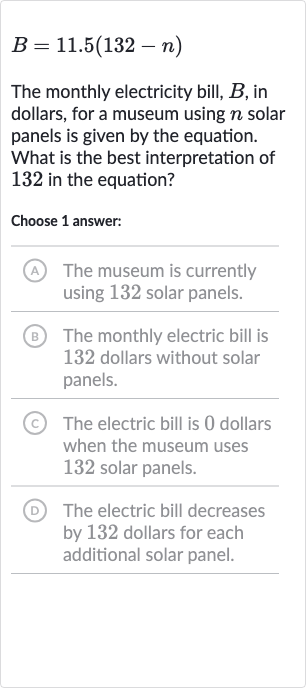AI tutor
Welcome to Bytelearn!
Let’s check out your problem:

The monthly electricity bill, , in dollars, for a museum using solar panels is given by the equation. What is the best interpretation of in the equation?Choose answer:(A) The museum is currently using solar panels.(B) The monthly electric bill is dollars without solar panels.(C) The electric bill is dollars when the museum uses solar panels.(D) The electric bill decreases by dollars for each additional solar panel.
Full solution
Q. The monthly electricity bill, , in dollars, for a museum using solar panels is given by the equation. What is the best interpretation of in the equation?Choose answer:(A) The museum is currently using solar panels.(B) The monthly electric bill is dollars without solar panels.(C) The electric bill is dollars when the museum uses solar panels.(D) The electric bill decreases by dollars for each additional solar panel.
- Understand Equation Components: Analyze the equation to understand what each component represents.The equation gives us the monthly electricity bill in dollars for a museum using solar panels. The bill is calculated by multiplying by the difference between and the number of solar panels .
- Consider Interpretations Given: Consider the interpretations given in the choices.(A) suggests that is the current number of solar panels in use, which doesn't make sense in the context of the equation since is the variable representing the number of solar panels.
- Examine Monthly Electric Bill: Examine choice (B) which suggests that the monthly electric bill is nB=.()B=.\times dollars, so this interpretation is incorrect.
- Evaluate Electric Bill Scenarios: Look at choice (C) which suggests that the electric bill is dollars when the museum uses solar panels.If we set to , the equation becomes , which simplifies to . This results in , which means the electric bill would indeed be dollars if the museum uses solar panels. This interpretation seems to be correct.
- Evaluate Electric Bill Scenarios: Look at choice (C) which suggests that the electric bill is dollars when the museum uses solar panels.If we set to , the equation becomes , which simplifies to . This results in , which means the electric bill would indeed be dollars if the museum uses solar panels. This interpretation seems to be correct.Finally, consider choice (D) which suggests that the electric bill decreases by dollars for each additional solar panel.This interpretation is not correct because the decrease in the bill for each additional solar panel is proportional to the coefficient , not . The number represents a fixed number, not a rate of decrease.
More problems from Interpret parts of quadratic expressions: word problems
QuestionGet tutor help
QuestionGet tutor help
QuestionGet tutor help
QuestionGet tutor help
QuestionGet tutor help
QuestionGet tutor help
QuestionGet tutor help
QuestionGet tutor help
